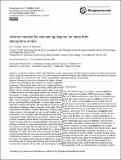| dc.contributor.author | Forney, David C. | |
| dc.contributor.author | Rothman, Daniel H. | |
| dc.date.accessioned | 2013-01-24T20:38:33Z | |
| dc.date.available | 2013-01-24T20:38:33Z | |
| dc.date.issued | 2012-09 | |
| dc.date.submitted | 2012-03 | |
| dc.identifier.issn | 1726-4189 | |
| dc.identifier.issn | 1726-4189 | |
| dc.identifier.uri | http://hdl.handle.net/1721.1/76602 | |
| dc.description.abstract | Long-term organic matter decomposition experiments typically measure the mass lost from decaying organic matter as a function of time. These experiments can provide information about the dynamics of carbon dioxide input to the atmosphere and controls on natural respiration processes. Decay slows down with time, suggesting that organic matter is composed of components (pools) with varied lability. Yet it is unclear how the appropriate rates, sizes, and number of pools vary with organic matter type, climate, and ecosystem. To better understand these relations, it is necessary to properly extract the decay rates from decomposition data. Here we present a regularized inverse method to identify an optimally-fitting distribution of decay rates associated with a decay time series. We motivate our study by first evaluating a standard, direct inversion of the data. The direct inversion identifies a discrete distribution of decay rates, where mass is concentrated in just a small number of discrete pools. It is consistent with identifying the best fitting "multi-pool" model, without prior assumption of the number of pools. However we find these multi-pool solutions are not robust to noise and are over-parametrized. We therefore introduce a method of regularized inversion, which identifies the solution which best fits the data but not the noise. This method shows that the data are described by a continuous distribution of rates, which we find is well approximated by a lognormal distribution, and consistent with the idea that decomposition results from a continuum of processes at different rates. The ubiquity of the lognormal distribution suggest that decay may be simply described by just two parameters: a mean and a variance of log rates. We conclude by describing a procedure that estimates these two lognormal parameters from decay data. Matlab codes for all numerical methods and procedures are provided. | en_US |
| dc.language.iso | en_US | |
| dc.publisher | Copernicus GmbH | en_US |
| dc.relation.isversionof | http://dx.doi.org/10.5194/bg-9-3601-2012 | en_US |
| dc.rights | Creative Commons Attribution 3.0 | en_US |
| dc.rights.uri | http://creativecommons.org/licenses/by/3.0/ | en_US |
| dc.source | Copernicus | en_US |
| dc.title | Inverse method for estimating respiration rates from decay time series | en_US |
| dc.type | Article | en_US |
| dc.identifier.citation | Forney, D. C., and D. H. Rothman. “Inverse Method for Estimating Respiration Rates from Decay Time Series.” Biogeosciences 9.9 (2012): 3601–3612. | en_US |
| dc.contributor.department | Massachusetts Institute of Technology. Department of Earth, Atmospheric, and Planetary Sciences | en_US |
| dc.contributor.department | Massachusetts Institute of Technology. Department of Mechanical Engineering | en_US |
| dc.contributor.mitauthor | Forney, David C. | |
| dc.contributor.mitauthor | Rothman, Daniel H. | |
| dc.relation.journal | Biogeosciences | en_US |
| dc.eprint.version | Final published version | en_US |
| dc.type.uri | http://purl.org/eprint/type/JournalArticle | en_US |
| eprint.status | http://purl.org/eprint/status/PeerReviewed | en_US |
| dspace.orderedauthors | Forney, D. C.; Rothman, D. H. | en |
| dc.identifier.orcid | https://orcid.org/0000-0003-4006-7771 | |
| mit.license | PUBLISHER_CC | en_US |
| mit.metadata.status | Complete | |
